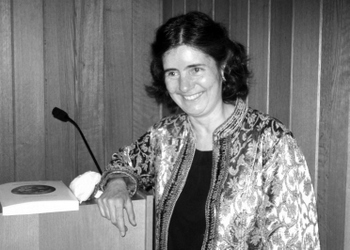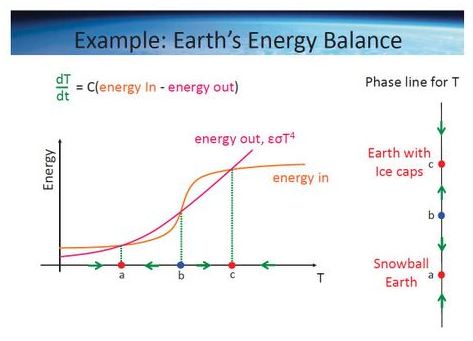- About MAA
- Membership
- MAA Publications
- Periodicals
- Blogs
- MAA Book Series
- MAA Press (an imprint of the AMS)
- MAA Notes
- MAA Reviews
- Mathematical Communication
- Information for Libraries
- Author Resources
- Advertise with MAA
- Meetings
- Competitions
- Programs
- Communities
- MAA Sections
- SIGMAA
- MAA Connect
- Students
- MAA Awards
- Awards Booklets
- Writing Awards
- Teaching Awards
- Service Awards
- Research Awards
- Lecture Awards
- Putnam Competition Individual and Team Winners
- D. E. Shaw Group AMC 8 Awards & Certificates
- Maryam Mirzakhani AMC 10 A Awards & Certificates
- Two Sigma AMC 10 B Awards & Certificates
- Jane Street AMC 12 A Awards & Certificates
- Akamai AMC 12 B Awards & Certificates
- High School Teachers
- News
You are here
Harnessing Math to Understand Tipping Points

Mary Lou Zeeman in the MAA Carriage House
Bowdoin College professor Mary Lou Zeeman came to the MAA Carriage House on March 28 focusing on hope. "When we're educating, it's way too easy to talk about problems," she told the Carriage House crowd. "And it's not good for our students to hear only this doom and gloom."
Codirector of the Mathematics and Climate Research Network, which connects researchers deploying mathematics to better understand Earth's climate, Zeeman wants to empower those she teaches to seek solutions to today's environmental ills.
Although Zeeman stressed that one needn't be an engineer or a scientist to contribute to positive change, her Distinguished Lecture demonstrated how her own field of study—mathematics—can help make sense of our complex world.
In "Harnessing Math to Understand Tipping Points," Zeeman stuck to discussing simple dynamical models, noting that these models often yield insights that inform the more complex computational models used in prediction. A member of the teams that organized the Mathematics of Planet Earth 2013 initiative and this year's Mathematics Awareness Month on sustainability, Zeeman focused on examples relevant to environmental concerns: Earth energy balance and the nutrient loading of a shallow lake.
Considering such factors as albedo and black body radiation and greenhouse gas absorption, Zeeman sketched graphs of the energy going in and out of the Earth's system. She collapsed information from the graphs into a phase line, a one-dimensional representation of dynamics and critical points.

A slide from Zeeman's presentation shows a phase line.
Zeeman's graphs raised the specter of a "snowball Earth," which would be the extreme opposite of an ice-free planet. Analogously, a lake can be clear or, if algae come to dominate the ecosystem, turbid.
"Or if you're in your kayak," Zeeman quipped. "You have two stable states, the preferred one and the less preferred one."
Next Zeeman tackled resilience. Ecology defines the word as "how much perturbation a system can withstand," but, by reading from the phase line the effects of different amounts of perturbation, Zeeman led the audience to a more mathematical characterization of the concept. "Resilience is the radius of the basin of attraction," she said.
Zeeman then readjusted her original graphs to reflect a hypothetical decrease in the amount of greenhouse gases in the atmosphere. She demonstrated that, depending on the magnitude of the decrease, equilibria could coalesce or disappear.
Shifts would occur in an ice-free planet as well. Humans are good at increasing greenhouse gases, Zeeman said. "We wish we were not so good at it."
Zeeman stacked the phase lines corresponding to various amounts of greenhouse gas to generate a diagram showing curves of stable and unstable equilibria.
Coming back to a question posed earlier in the lecture, Zeeman explained how Earth emerged from the snowball state it evidently occupied 600 million years ago. While volcanoes spewed greenhouse gases into the atmosphere, the planet's icy blanket prevented these gases from being removed via weathering of rocks or oceanic absorption of carbon. As greenhouse gases increased, the resilience of the stable snowball state decreased until, when it shrunk to nothing, the system tipped. A very hot Earth resulted: all the ice melted, rocks and oceans were exposed, and "all those mechanisms for drawing carbon out of the atmosphere [were]…accessible again."
When mathematicians spot a trend such as a decrease in resilience as a system nears a tipping point, "we want to really extract all the structure we can…and see how we can use it," Zeeman said.
She reported that the team led by Marten Scheffer has investigated the possibility of using that structure to predict tipping points even when the system in question is too big or too complex to be fully understood. Scheffer has observed the same patterns identified in simple, one-dimensional models in the data leading up to abrupt transitions in the real-life climate system, financial markets, and ecosystems.
Zeeman would like to see insights from the math and science of resilience folded into policy decisions in situations—urban planning, say—where humans have some control over the gradually changing environment in which the system is located. Managing for resilience rather than efficiency might help us tread more lightly on the planet, for example.
She'd like policymakers and math-savvy scientists to confront challenges together, to explore in tandem models that incorporate those parameters we could "spend money on and actually change."
Zeeman wishes for better communication. Too often, she said, the two camps seem "like the guys and the girls on the opposite sides of the room and nobody dancing." —Katharine Merow
 Listen to an interview with Mary Lou Zeeman and MAA Director of Publications Ivars Peterson (mp3)
Listen to an interview with Mary Lou Zeeman and MAA Director of Publications Ivars Peterson (mp3)

This MAA Distinguished Lecture was funded by the National Security Agency.




